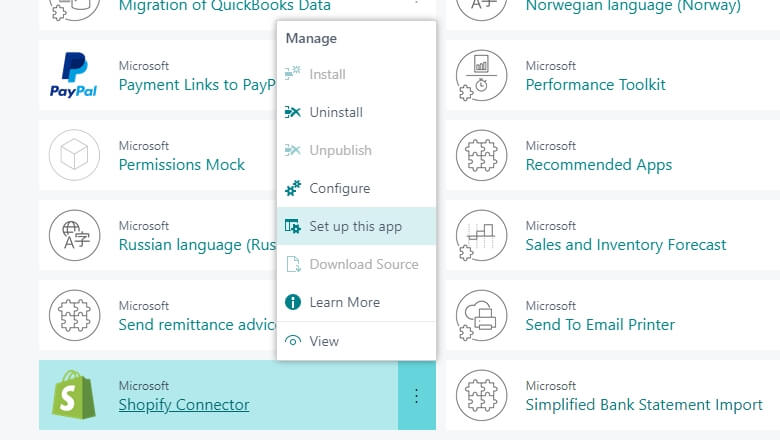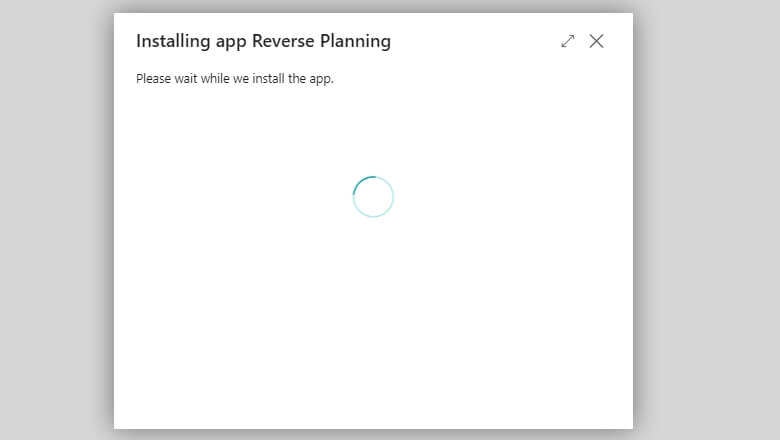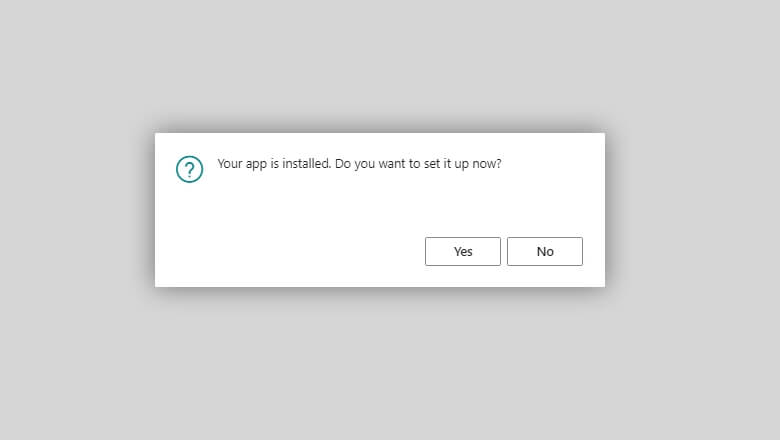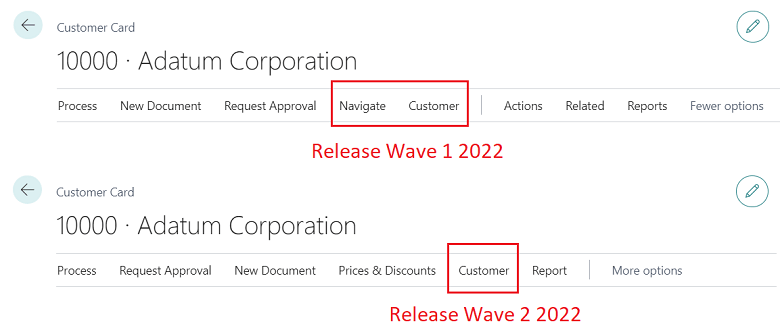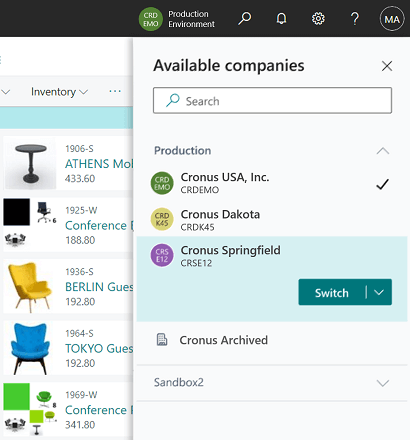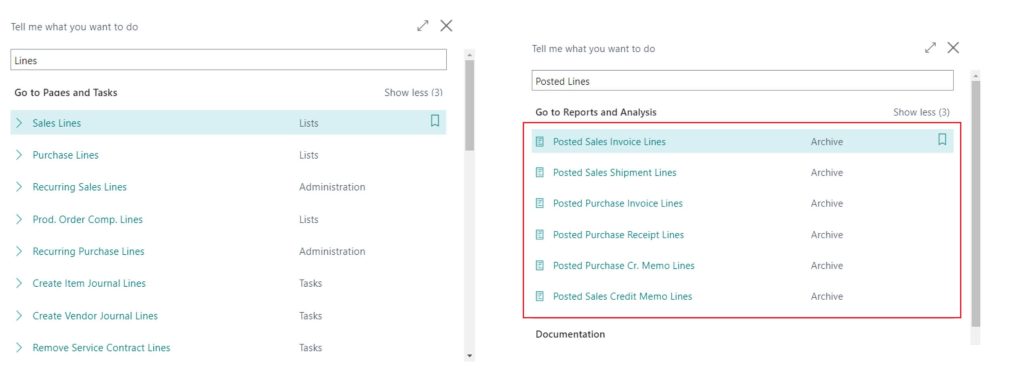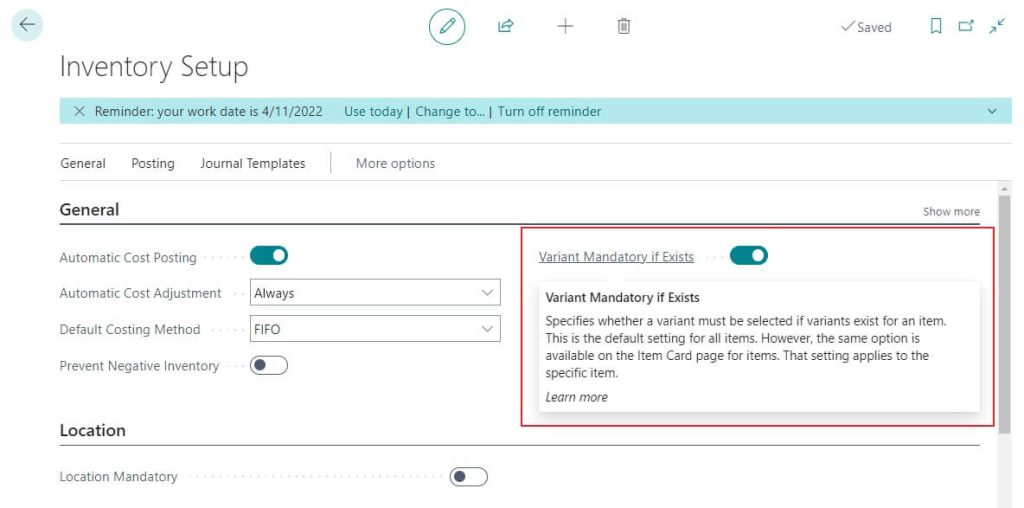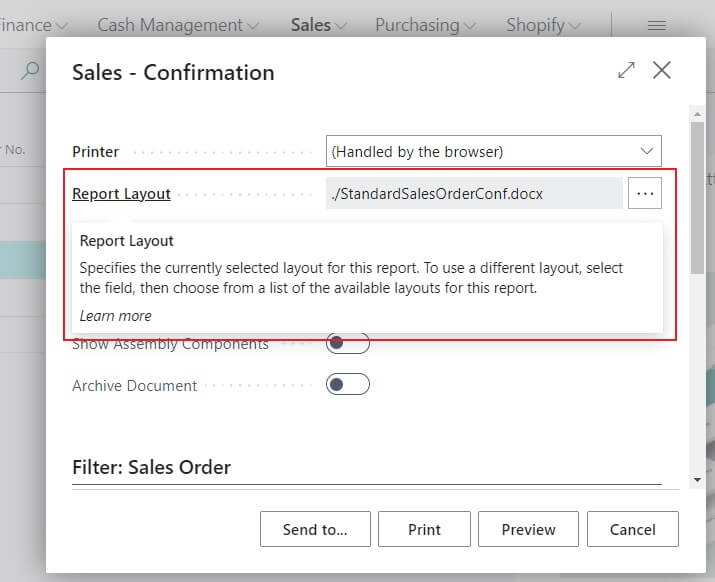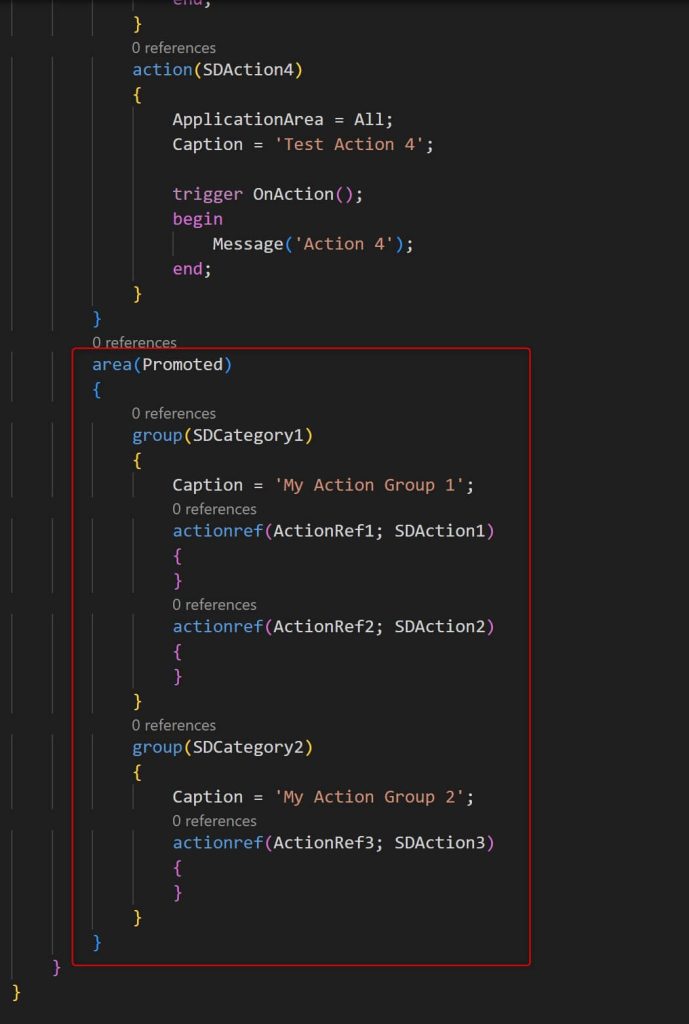October is here, and this is the month for a new major release of our favorite ERP every year. At the beginning of October 2022, Dynamics 365 Business Central 2022 Wave 2 release (or version 21) will be available to the public. Starting from that date, new online customers will be deployed on version 21, while existing customers will be upgraded to version 21 in the upcoming weeks. Also, the packages for the v21 on-premise version and the new AL language extension version (version 10.x) will be available to download. But what changes expect for us starting from October 2022?
As usual, there will be small or big changes (new features or improvements) in different areas, and I think that you know that together with Simplanova, we’ll have a webcast on Thursday, October 6, 2022, 04:00 PM CEST (Central European Summer Time) for explaining all the upcoming changes. The link for registering for the webcast is HERE.
In this article, I don’t want to list or explain all the upcoming changes in version 21, but I want to put in evidence some of them and talk a bit about “long-term plans”.
The important due dates to remind
There are some important due dates that you should remind to avoid service disruption in the upcoming Business Central versions.
With Dynamics 365 Business Central 2022 Wave 2 (version 21), the Business Central Server Administration tool for configuring the Business Central Server in on-premises installations will be removed. From version 21, Powershell and the Business Central Administration Shell will be the one and only administration tools for the server platform.
Later, with Dynamics 365 Business Central 2023 Wave 1 (version 22):
- Support for the .flf file format for Business Central license files for on-premises deployments will be removed. The new .bclicence file format will be the only supported from version 22 and the next releases (you will not be able to download or import the .flf file in versions >= 22). For the older Business Central versions (<= 21), partners can download a zip file from Partner Center containing .flf and .bclicense files.
- Support for using an Application Insights instrumentation key to set up telemetry for Business Central environments or apps will be removed. Azure Applications Insights connection string will be the only supported way to ingest telemetries.
- .NET add-ins compiled with .NET Framework won’t work in Business Central 2022 release wave 2. .NET Standard has superseded .NET Framework, and if you have .NET add-ins for Business Central, please check to be .NET Standard compliant. I wrote some posts here and here in the past about this topic.
Another significant change to remember is how to establish relationships with your customers for Dynamics 365 Business Central SaaS. The way to establish a partner relationship with an online customer in the past was to send him a Delegated Admin Privilege (DAP) request.
Delegated Admins Privileges (DAP) are widely used for administering Dynamics 365 Business Central tenants. Still, they have a possible drawback: they can give you access as Global Admin to your customer tenants, so if you are compromised (alias hacked), your customers could be affected.
The new GDAP capability will allow partners to control more granular and time-bound access to their customers’ workloads, to better address their customers’ security concerns. Partners can also offer more services to customers who may be uncomfortable with the current levels of partner access or those with regulatory requirements to provide only least-privileged access to partners.
With DAP, you can have the following two access roles:
- Global Admin
- HelpDesk Agent
And the relationship timeline is indefinite (it lives until the customer revokes it). The customer needs to accept the relationship via a link that is the same for every customer.
With GDAP, you can set up custom access roles with custom relationship timelines (maximum of 2 years, after that, it must be renewed) by accepting a relationship from a customer-specific link. All GDAP related operations are logged into the Azure AD Activity logs for traceability.
With DAP, the same level of access is given to all members within a Partner Center environment for a specific customer. At the same time, with GDAP, you can create security groups with particular roles.
What changes now?
Starting from October 2022:
- Microsoft will stop creating DAPs when a new customer or reseller relationship is formed. As a result, partners will need to update their process for acquiring new CSP customers to request GDAP permissions from customers.
- Microsoft will start removing DAPs that have been inactive for 90 or more days. If admin privileges are needed, the partner should create a GDAP relationship with the customer with the appropriate access level and time required to manage their customer’s service.
- Microsoft will transition active DAP connections to least privileged GDAP roles starting October 31, 2022.
If you have a large number of online customers, to help speed up this transition, Microsoft has released a GDAP bulk migration tool that I’ve described here. Please take a look if you have this need.
Administration changes
When administering the Dynamics 365 Business Central 2022 Wave 2 release, one of the most significant changes, in my opinion, is the long-requested service-to-service (S2S) authentication for the Business Central administration center API. This way, admins can run lifecycle operations across all environments in all Azure AD tenants they manage in one go without having to reauthenticate for each customer they manage.
But there’s more…
In this way, you can finally schedule silent operation (scheduled tasks) that performs administrative operations on a tenant. Imagine a timer-triggered workflow automatically recreating a sandbox from a production environment without daily manual interaction. Now this will be possible.
Another important new feature is related to the deletion of environments. Actually, you cannot restore a deleted environment by yourself. From version 21, environments are placed in a “soft-deleted” state for seven days after you delete them. Environments in the soft-deleted state will be visible in the Admin Center, and admins can restore such an environment without having to involve Microsoft support. This feature will not be immediately available, but the actual plans are to release it to the SaaS tenant in November.
Onboarding changes
Microsoft is investing a lot in onboarding features to help customers have the possible smart experience of configuring Business Central and installing the apps they need for their business.
Business Central version 21 introduces an interesting feature for executing an extension’s setup page directly from the Extensions Management page if the extension has specified a setup page. Of course, the app developer should reference the setup page in the app manifest so that Business Central knows which page to run for the specific app. In v21, new action on the Extensions Management page permits you to automatically run the setup page that the developer specified for the selected app:
Also, when you install an app from AppSource, the platform now alerts you about the progress of the installation process:
and then can guide you through initiating the relative app setup process:
User interface changes
Dynamics 365 Business Central action bar is something that sometimes the users find not so intuitive to use, especially because actions are not always easy to find.
In this new release, the action bar is updated with improvements like keeping related actions together and avoiding the same action being available in multiple menus.
The Navigate menu previously available on some pages has been retired, and its contents merged with the entity menu. The entity menu is the one bearing the name of the entity displayed on a page, such as a Customer on Customer Card or Order on Sales Order, and it is now the primary menu for information related to the current record:
You also have a new way to define and promote actions and action groups in the AL code (more on that later).
Application changes
Switching companies across the application or tenants were not so immediate. In this new release, a newly redesigned company switcher pane is available:
It will make it easier to get an overview of the companies and environments you have access to and to switch contexts rapidly. You can activate the company switcher pane anywhere in Business Central, either from the app bar or using a keyboard shortcut.
Open and Posted lines pages are now available for all documents:
When working with Items, you can now require that users specify the variant in documents and journals for items that have variants:
One of my favorite features of this release is related to reporting: you can now choose which report layout to use on the report’s request page:
This will use different report layouts for different purposes, especially Excel layouts.
Development changes
Developers have new features available to improve their applications, and more will come in future releases.
You can now see SQL lock in Visual Studio Code for the debugged session:
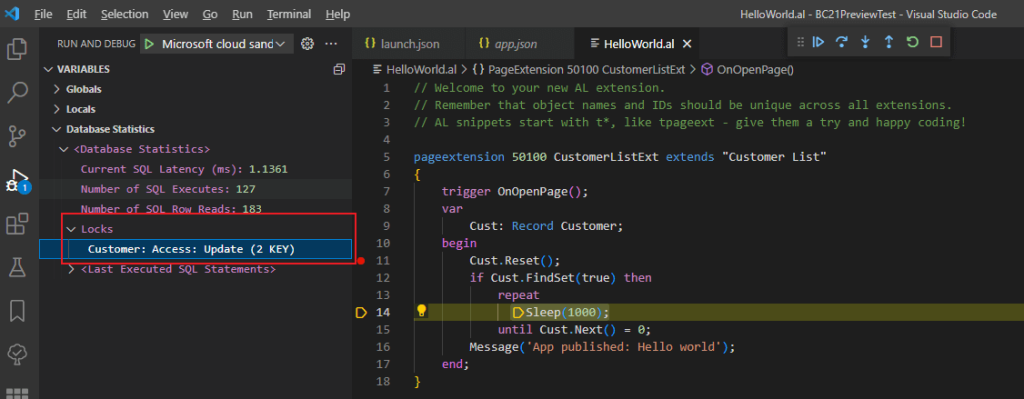
You will have an excellent way to promote actions in the action bar via the AL code. This new way (based on the new actionref keyword) will permit you to create a more immediate toolbar for your users:
More details about this feature are here.
One of the most remarkable features is the upgrade process of extensions. A new DataTransfer data type is introduced, allowing you to execute set-based SQL queries, resulting in 90x faster upgrade processes. The latest data type can be used only on upgrade codeunits, but stay tuned for more in the future. More information about this new data type is here.
There are other features, but more on the upcoming webcast.
What about the future?
Dynamics 365 Business Central is a large, growing ERP. The last customer growth analysis shows that the ERP is growing more than 60% year over year (now we have more than 3800 partners and more than 2700 apps on AppSource). Dynamics 365 Business Central has the largest number of apps in Microsoft’s marketplace.
Microsoft is constantly improving the Business Central platform to be always more open and “state of the art.” Expect in the next waves interesting investments on AppSource (monetization and more), on the platform itself (telemetry, data export, data analysis, and more), on Power Platform integration, and on the development tools (an alpha release of a Visual Studio Code integrated “object designer” is on the horizon).
But what’s the biggest change, in my opinion?
Microsoft wants to move Business Central System and Base Application on GitHub and open the platform for contributions, and the same for all other extensions. If you wish to contribute, go to aka.ms/ChangeALModule or aka.ms/NewALModule and submit your pull request.
This is a big mind shift. Opening the platform means more interaction with the partners’ communities and more possibilities to improve the platform and fix bugs. This is a big opportunity for everyone.
The future is brilliant…
